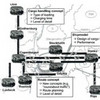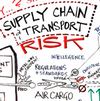 Someone had to come up with this, it was just a matter of time, and it is no suprise that this article comes from India, one of the major providers of global outsourcing for many industries. In an article reviewing some 100 references, Babu & More (2008) Perspectives, practices and future of supply chain flexibility, the focus is on anything supply chain flexibility, really anything that relates to supply chain flexibility. And honestly, I must say, they don’t leave much ground uncovered.
Someone had to come up with this, it was just a matter of time, and it is no suprise that this article comes from India, one of the major providers of global outsourcing for many industries. In an article reviewing some 100 references, Babu & More (2008) Perspectives, practices and future of supply chain flexibility, the focus is on anything supply chain flexibility, really anything that relates to supply chain flexibility. And honestly, I must say, they don’t leave much ground uncovered.
Finding myself
It is actually quite interesting how I found this article. Remember my post on the Catch 22 of Academic Publishing? In that post I realized that the final value of academic publishing lies maybe not in the number of articles you publish, but in the number of publications that are actually cited. The higher the number of citations, the higher the level of utility. As it turns out, many of the articles on this site, which indeed are academical work, but are far from being academically published (as in academic journals), are nonetheless widely used in the academic community, even to the point of being mistaken for my PhD. As I was following up on my post on the actual scholarliness Google Scholar, I decided to put Google Scholar to the test and search for myself to see what else that would turn up. That is how I came across the article for today’s post, where the author had used a very early (and I’m compelled to say ‘premature’) version of my thoughts on flexibility and robustness as one of their references.
Attempting to make sense of it all
The way the authors go about in their review is reminiscent of the approach in an article previously reviewed on this blog, namely Vanany, Zailani and Pujawan (2009) Supply chain risk management: literature review and future research, where the focus was on anything supply chain risk management, hence my title for today, reflecting on the very similar title for my review of Vanany et al, Supply chain risk management – a complete review? And do Babu & More (2008) deliver a complete review of anything supply chain flexibility?
The review of More & Babu
In their 34-page review the authors examine an impressive list of 107 articles and classify various aspects of supply chain flexibility. It is indeed a voluminous paper and not the easiest to keep oversight in, and the authors do a formidable job in keepings things separate, I have to give them credit for that. So, let me give you a short run-down off the essential findings:
Understanding supply chain flexibility
First, More & Babu highlight some of the definitions and characteristics of (supply chain) flexibility used in their list of articles, before reverting to a definition of supply chain flexibility they themselves used in a previous conference presentation:
the inherent ability, or characteristics of the supply chain and its partners,
- to be sensitive to minor and major disturbances in the business environment,
- to correctly assess the actual situation,
- to quickly respond, adjust and adapt with little time, effort and cost, and
- to effectively control the organization, and
- to keep the performance stable.
While I agree that this definition encompasses most elements that need to be in place for a supply chain to be flexible, in my opinion it is not ‘crisp’ enough and it does not stand out vis-a-vis supply chain agility. However, the difference is clarified later in this paper, and I realize that the author use supply chain flexibility as an overarching or overlapping concept,that has much common ground with other concepts.
Types of supply chain flexibility
In defining ‘types’ of supply chain flexibility the author list no less than 71 different types, linking each type with the appropriate reference. I believe that some of these could and should be aggregated into other types, thus reducing the overall number, but it only goes to show that flexibility in one industry is different from flexibility in another industry.
Dimensions of supply chain flexibility
After describing the various types of supply chain flexibility, More & Babu propose three domains of dimensions for supply chain flexibility:
- core flexibility
- global flexibility
- supplemental flexibility
Core flexibility, obviously being the most important dimension, is described more in detail, the others more cursory. This is not a glitch, but only natural, since the other dimensions essentially are a result of core flexibility, which relates to:
- Manufacturing
- Sourcing/Procurement/Purchasing
- Logistics Distribution
- Information and communication (ICT)
- Organization
- Human resources
- Market
Global flexibility is essential for achieving spatial and temporal flexibility and is seen as a response to environmental uncertainty. Although not clearly defined in the article, global flexibility encompasses all elements needed for stretching a supply chain around the globe, from supplier to end customer, particularly related to a network that can change time and space.
Supplemental flexibility appears as a rather foggy concept and I am not sure what the authors mean, but I guess it is anything else related to flexibility and not covered above. Or it could be flexibility that is not intended or designed or built in, but just happens to be there when needed?
Supply chain flexibility for business excellence
This section of the article deals with supply chain principles and how they relate to or are different from supply chain flexibility. I should add that while some of them are well described and well discussed, others are only given a more cursory review.
Supply chain flexibility – lean
While lean may work well in a predictable and non-volatile environment, flexible works better when faced with disruptive events.
Supply chain flexibility – agile
Agility is an extended concept of flexibility, and is achieved when the system is inherently flexible and able to repond to unpredictable events. A flexible system can be, but isn’t always agile; an agile system is always flexible.
Supply chain flexibility – responsive
Responsiveness is the ability to react to customer demands or market changes. An inherently flexible system is able to respond; however, it is possible to be flexible, but not responsive, while responsiveness will always imply that there is an underlying flexible system. A flexible supply chain with time (to meet and satisfy the changes) as the primary constraint is a responsive supply chain.
Supply chain flexibility – resilient
Here the authors follow Sheffi in that more flexibility equals more resilience, thus enabling continuous reconstruction and the ability to bounce back after any disturbance.
Supply chain flexibility – robust
Interestingly, my own article on robustness and flexibility, which they reference, makes it into the ‘robust’ category. I’m not sure that’s where I would put it, but maybe yes. At that time (2004) my ideas on flexibility were still in the molding. However, as More & Babu see it, flexibility is an external concept, robustness is an internal concept, being flexible is to adapt and adjust, being robust is to accommodate and absorb. Faced with a disruption or external event, a robust supply chain will continue unchanged, while a flexible supply chain will continue changed. Robust is being risk averse and seeking certainty. Flexible is accepting uncertainty and and the risk that comes with it. I am not sure that is how I saw it in 2004, but looking back at my definitions of robust and flexible, yes, that interpretation is justified.
Forces and dynamics of supply chain flexibility
This is one of the more interesting parts of the paper, where they look at three (four) new terms: (domains and) stimuli, enablers and inhibitors, all contributing to how, or how not, supply chain flexibility can be achieved. The individual items pertaining to these terms make up an impressive list, which is very thorough, drawn from the reviewed literature.
Stimuli
Stimuli are the elements that compel the supply chain partners to take actions in response to a changing environment. Listing 16 domains (e.g. customer, competitor, technology, market, product, and 13 more…), the authors look at which stimuli that would bring forth supply chain flexibility. In technology, for instance, it could be rapid advances in technology, in product it could be shorter and shorter life cycle of products, and so on. Some 70 or so stimuli are listed.
Enablers
Enablers are tools and techniques that support the implementation or realization of supply chain flexibility. The authors divide the enablers according to six ‘segments’ in the supply chain, starting with supply and procurement, and divided into sub-segments, and list some 150-200 enablers (I gave up counting).
Inhibitors
Inhibitors are internal and external forces that impede the supply chain. Here we have another ‘everything that comes to mind’ list, including no less than 62 inhibitors, ranging from market constraints to the more mundane ‘low morale’.
The dynamics of three forces
This is where the paper really lets me down, slightly. While the discussion itself is excellent, the figure that is supposed to illustrate the three concepts and the discussion leading up to it, is more or less completely void of any of the aforementioned, at least in the way it was presented. It is almost as if this is a completely different model, a good model, but not what I expected.
The verdict
The basic message I am reading out of this paper is that ‘It is all supply chain flexibility’, whatever we name it, whatever other concepts we bring in, it all comes down to one thing: being flexible. I am also impressed with the breadth of the paper. That is the upside.
If there is a downside to this paper it has to be the length and the attempt at being exhaustive to the point of including way too much detail. This leads to an overly lengthy listing of items, i.e. the discussion of stimuli, enablers and inhibitors, which would have fared much better had it been focused on a few aggregated items. While the stimuli, enablers and inhibitors are said to be drawn form the literature, no particular references are made to which is drawn from which literature.
I would also have liked to see the a model that actually incorporates the three forces.
While apparently geared towards manufacturing and operations, the wider scope of supply chain seems to be somewhat missing from the paper, e.g. I did not find the any of the seminal papers by Cooper, Lambert and Pagh in their reference list. Not that they should have been there, not really, but I usually expect at least one of those papers in a paper on supply chains.
Conclusion
That said, given the breadth and length, there IS much food for thought. And to answer the question stated in my title, yes, it is a complete review of supply chain flexibility as far as I am able to judge.
Reference
More, D., & Babu, A. (2008). Perspectives, practices and future of supply chain flexibility International Journal of Business Excellence, 1 (3) DOI: 10.1504/IJBEX.2008.017885
Links
- linkedin.com: A Subash Babu
- linkedin.com: Dileep More












